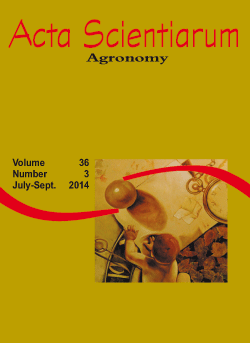<b>Effects of wounding, humidity, temperature, and inoculum concentrations on the severity of corky dry rot caused by <i>Fusarium semitectum</i> in melon fruits
Resumo
Corky dry rot, caused by Fusarium semitectum, is the main postharvest disease of melons in Brazil. This study investigated the effects of wounding, humidity, temperature, and inoculum concentration on the severity of corky dry rot under controlled conditions. Cantaloupe and honeydew melon types were inoculated by spraying conidial suspensions of three F. semitectum isolates. In all experiments, the tested F. semitectum isolates did not differ in relation to disease severity, but, the cantaloupe melon showed higher levels of severity. No lesions appeared on fruits that lacked wounds, and increasing wound age reduced lesion severity. Melons that were inoculated with F. semitectum developed symptoms regardless of the presence or absence of a moist chamber at the post-inoculation stage, but the lesions were larger under moist chamber conditions. There were no symptoms at 10°C, but a temperature increase from 15 to 25°C resulted in a disease severity increase. The largest lesions were observed when both melon types were inoculated with a concentration of 106 conidia mL-1, but even the lowest concentration (101 conidia mL-1) was sufficient for causing lesions. Injury reduction and/or the acceleration of melon healing, as well as environmental variable control and a reduction of inoculum sources, are essential to reducing corky dry rot severity.
Downloads
DECLARAÇÃO DE ORIGINALIDADE E DIREITOS AUTORAIS
Declaro que o presente artigo é original, não tendo sido submetido à publicação em qualquer outro periódico nacional ou internacional, quer seja em parte ou em sua totalidade.
Os direitos autorais pertencem exclusivamente aos autores. Os direitos de licenciamento utilizados pelo periódico é a licença Creative Commons Attribution 4.0 (CC BY 4.0): são permitidos o compartilhamento (cópia e distribuição do material em qualqer meio ou formato) e adaptação (remix, transformação e criação de material a partir do conteúdo assim licenciado para quaisquer fins, inclusive comerciais.
Recomenda-se a leitura desse link para maiores informações sobre o tema: fornecimento de créditos e referências de forma correta, entre outros detalhes cruciais para uso adequado do material licenciado.




















































